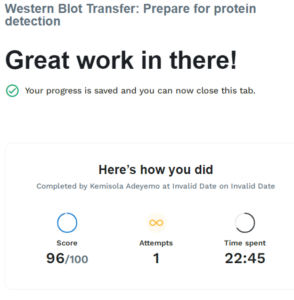COURSE
SCIE1046: Fundamentals Of Microbiology With Lab
1. About the Lab
Learning Objectives:
- Build a transfer stack with the correct orientation.
- Set up a transfer tank to transfer protein from an SDS-PAGE gel to a membrane.
- Critique the quality of protein transfer using a removable protein-identifying stain.
Estimated Length: 35 to 45 minutes
MAKE THE CONNECTION
The background information in section 2 was adapted from the following Microbiology lecture course Tutorials:
5.4.1 Antibody Production and Laboratory Testing
5.4.2 In Vitro Assays
2. Background Information
The following background information will be helpful as you prepare for the simulation.
2a. Immunoblot Assay
Protein gel electrophoresis can be followed by the addition of antibodies to identify specific proteins. This technique, described in the steps below, is called the Western blot.
STEP BY STEP
Step 1. Polyacrylamide gel electrophoresis (PAGE), is used to separate proteins on an electrophoresis gel.
Step 2. Protein antigens in the gel are transferred to a nitrocellulose membrane, immobilizing them.
Step 3. The nitrocellulose membrane is exposed to a primary antibody produced to bind to the protein of interest.
Step 4. A second antibody equipped with a molecular beacon (i.e., something that makes it visible) is added to bind to the first antibody (primary antibodies can also be tagged with a molecular beacon in some cases). Molecular beacons can be enzymes that will react with a chromogenic substrate to produce a color if the antibody is present. They can also be fluorophores (molecules that fluoresce when excited by light). The beacon indicates the location of the specific protein in the membrane.
The image below shows the steps of a Western blot in part (a) and an example of a Western blot test for antibodies to HIV in part (b). The bands on the Western blot indicate the presence of the protein of interest, which takes up stain.
Polyclonal antibodies are generally used for Western blot assays because they are able to bind to multiple epitopes of the primary antigen and are therefore more sensitive than monoclonal antibodies. However, monoclonal antibodies can also be used when there is a need to target specific epitopes.
TERM TO KNOW
This glossary term is important to know and will help you during the Activity.
Polyacrylamide gel electrophoresis (PAGE)
Polyacrylamide gel electrophoresis (PAGE) is a technique used to separate biological macromolecules according to their electrophoretic mobility.
Western Blot
Protein gel electrophoresis followed by the addition of antibodies to identify specific proteins.
2b. Antibody Production and Laboratory Testing
You are encouraged to review the complete Microbiology lecture course Tutorial 5.4.1 Antibody Production and Laboratory Testing for background on this topic before you begin the simulation.
3. Lab Manual
Lab Manual – Western Blot Transfer: Prepare for protein detection
This Lab Manual gives a synopsis of the lab and the theory behind it. You’re encouraged to read or download the manual before launching the lab. This information will also be available during the simulation by selecting the “Theory” tab on the virtual LabPad.
4. Launch Lab
You’re ready to begin! Review the helpful navigation tips below. Then click the “Launch Lab” button to start your lab. Be sure to answer all the questions in the simulation because they contribute to your score. Good luck, scientists!
- Exiting: To exit a lab simulation, press the ESC key on your keyboard. This key returns you to the objective screen for the simulation.
- Saving: You do not need to complete a simulation in one sitting. Labster saves your progress at predetermined checkpoints upon exit. To see your progress at any time, click on the “Mission” tab of the LabPad.
- Restarting: You are allowed an unlimited number of restarts for a simulation to improve your quiz score. Sophia and Labster will always store your best score.
- Just Browsing: You can restart a simulation to have a look around without completing it. The program will still retain your previous (and best) score.

